Day Six rolls around, and already I am starting to get that feeling that the end is upon us. Time is going way too fast, and there is no way, no matter how hard I try, to slow it down. Every moment is precious, from the quiet mornings up on the teak deck, still wet beneath my bare feet from the morning dew, to the near-full moon shimmering on the water, casting enchanting moon shadows across the surface until I can’t keep my eyes open any longer. I don’t want it to end. It’s that old catch-22 dilemma of not wanting to spend my last couple of days feeling sad, but not being able to stave off sadness because we are careening toward the end.
Today is going to be a busy day, which will make the time fly even faster. We typically have three activities throughout the course of a day, but today, we have four. We will start our day off the shore of North Seymour, an island that has been closed to visitors for a while.
North Seymour is a small island just north of Baltra, where the airport is located. It’s heavily populated with seabirds and over 2,500 land iguanas. But twice now in recent history, it has fallen prey (literally) to…eeek!!…rat infestation! They swim over from nearby Baltra. Who knew rats could swim? Not only do they eat bird eggs and small iguana and turtle hatchlings, they also compete for the wildlife’s food source, eating plants and seeds. So the island has been closed while they work to eradicate them. It’s only been reopened now for about a week. Good to know the coast is clear!

Coming ashore on North Seymour, we see one of the devices left behind to measure the effect of their recent rat eradication.
As I mentioned before, every island seems to have its own “feature,” something unique to offer. On the island of North Seymour, it’s frigate birds, and we will be doing a loop hike through the largest colony in the Galapagos.
There are two types of frigate birds, their names sounding quite boastful…the “Magnificent Frigate” identified by a purple sheen on his feathers and a blue circle around the female’s eye, and the “Great Frigate” having a green sheen to his feathers and a red circle around the female’s eye. As with the three similar species of Booby birds, the frigates avoid competition by feeding in different locations, with the Magnificents feeding along shore, while the Greats travel further out to sea to forage.
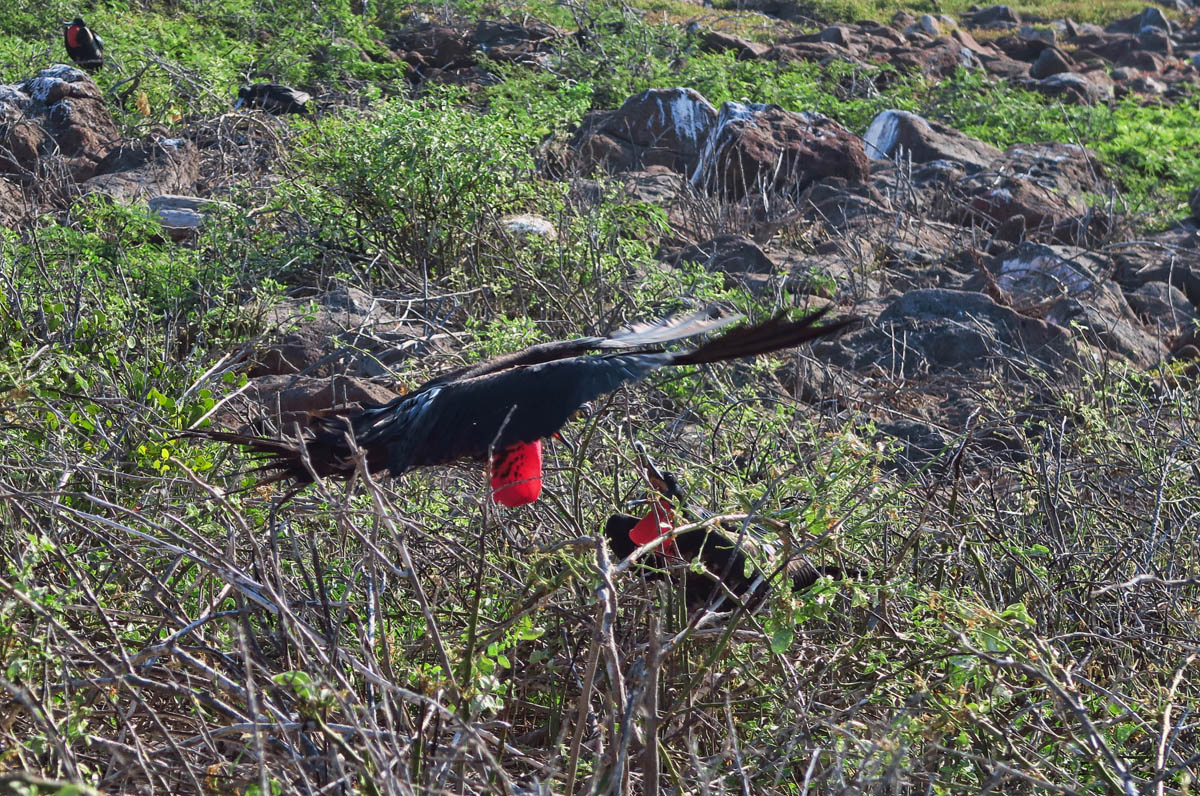
Just as I ask Fabian if a male can fly with an inflated pouch, this guy comes cruising by. (Hard to tell in the photo. He is headed toward the right, with his wings up over his head. Click on the photo to enlarge, then use the “browser back button” to return.)
Charles Darwin called the Galapagos frigate birds “the condors of the oceans,” because they have such large wingspans (largest wingspan to body weight ratio in the world) and can spend days and nights at a time “on the wing.”
Frigate birds have a small oil gland and lack weatherproofing on their feathers, so they must feed either on flying fish, or by stealing food from other birds, earning them the nickname of “pirate birds.” They do this by harassing them to the point of snatching them up by the tail feathers and shaking them around until they regurgitate. Thankfully, we were not witness to this feeding technique.
But the most distinguishable characteristic of the frigate bird is the male’s big red pouch, also known as a gular sac, which he inflates like a balloon to attract a mate, a process Fabian tells us takes about twenty minutes to inflate. The pouch puffed out on their chest looks almost heart-shaped. They use their beak against the pouch to make a drumming sound to attract females as they fly over.

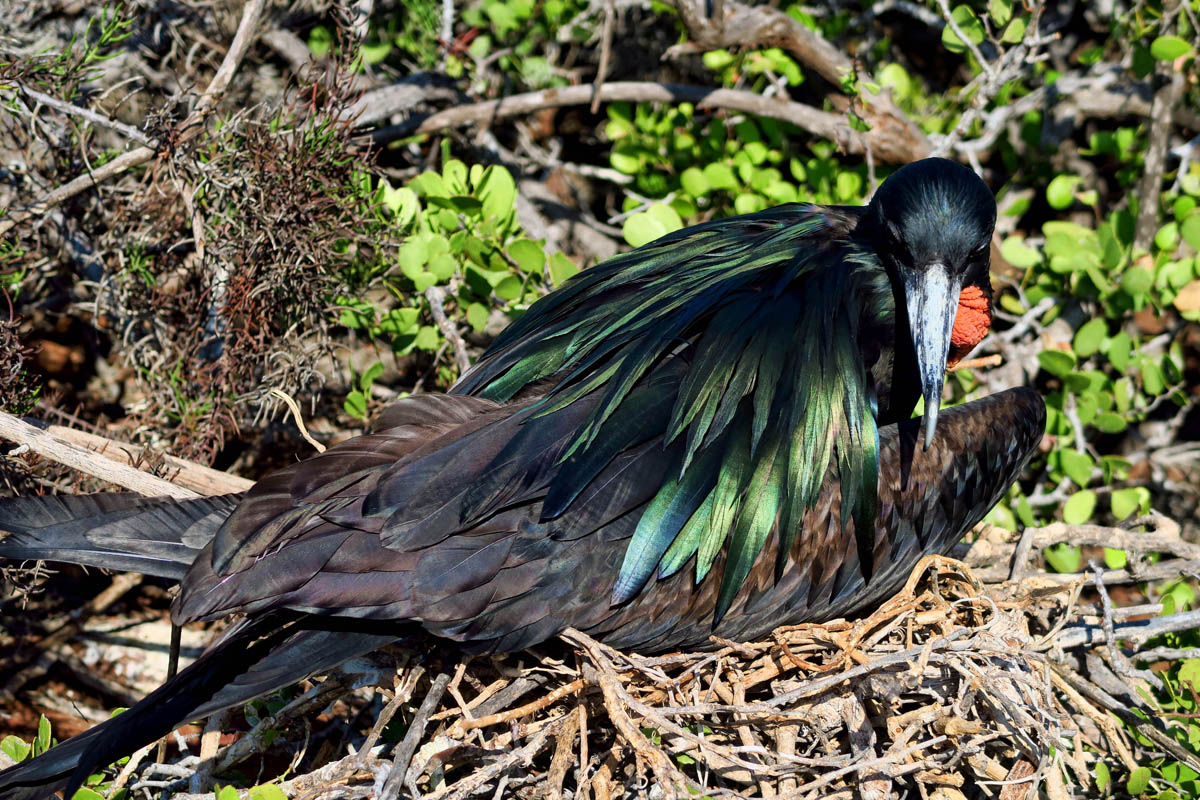
This is a Great frigate bird with a green sheen, while the magnificent has a purple iridescence in the sunlight.
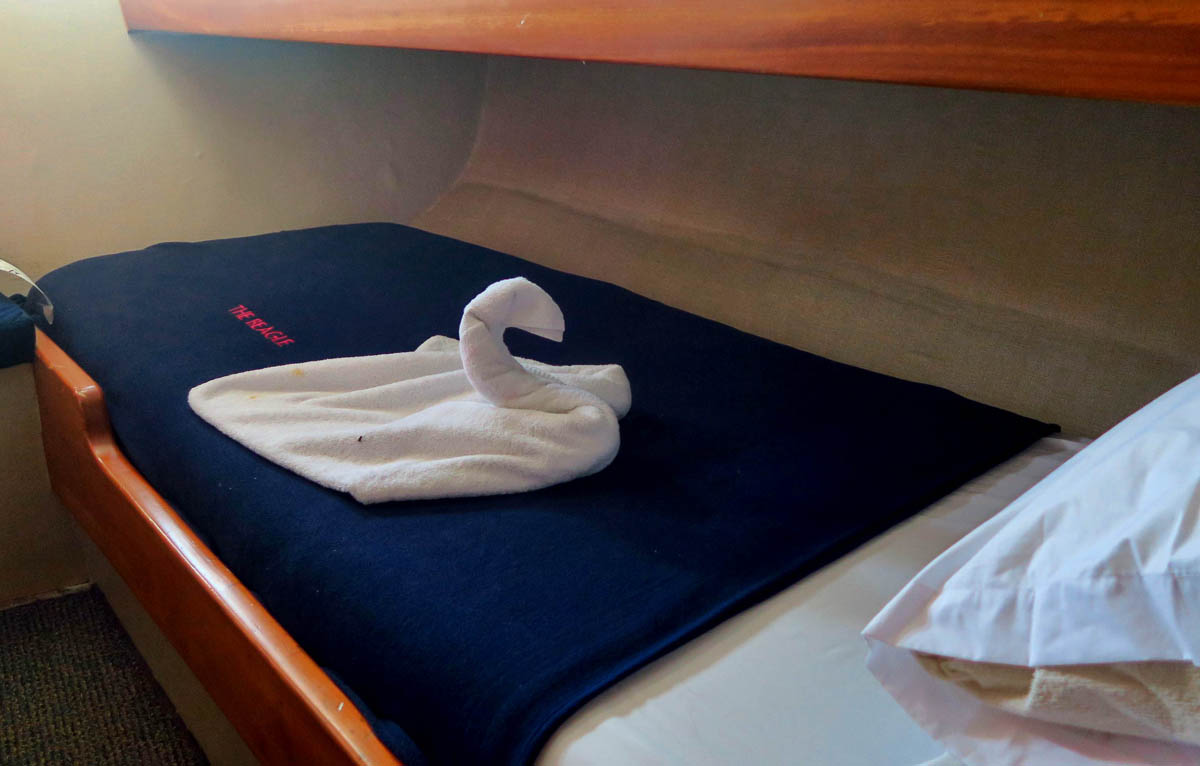
Back in my cabin, I am still seeing birds! I am not typically a fan of the “animal towels,” but being on a boat the size of the Beagle, I have come to know the person who folded these, making it now seem somewhat charming…
Once back in the zodiac, we go for a shoreline tour in search of fur seals. Not to be confused with sea lions, the fur seals are smaller, lighter in color, have larger, more bulbous eyes, and more pronounced ears than the sea lion. Having been hunted to the point of extinction for their fur coats, they are now on the endangered list. We did see one sunning on the rocky shore, but being on the somewhat crowded, bumpy rubber boat, my camera was stashed in the dry bag.
The snorkel following our hot hike is a welcome relief, and my favorite snorkel destination yet. The crew drops us off at one end of a rocky wall, and we drift with the current to the other end. The clear water is calm and refreshing (no wetsuit needed) and there is lots of marine life, including schools of yellow surgeon fish, parrot fish, and a few white-tipped sharks resting on the ocean floor. This is a popular scuba diving site, so we also encounter a group of divers along the way. I snorkel through their air bubbles racing for the surface.
Back on board in time for the best lunch yet, broccoli soup, fried shrimp, and passion fruit and blackberry sorbet. While I haven’t been that crazy about the dinner entrees, the crew hits it out of the park with the side dishes. Hardly a meal goes by that someone doesn’t remark, “wonder where they get all the fresh produce?” But the one thing I haven’t mentioned is the “snacks.” When we return from a hike or a snorkel, there is always a little treat waiting to refortify us after our activity. It’s either cold, frothy coconut milk, fresh limeade or fruit juice, accompanied by some kind of cookie or cracker (my favorite being the peanuts encrusted in sesame seeds.) While it’s not gourmet fare, the crew works tirelessly to make sure everyone is happy, and I hear no complaints…
Next stop on this busy day is Bartolomé Island, what is reported to be Galapago’s most photographed island, thanks to Hollywood. In 2003, the movie “Master and Commander” starring Russell Crowe was filmed here, featuring the islands most prominent sight, Pinnacle Rock. So we are here to get in on the selfie-action, along with the most boats we have seen yet since we left port.
But we are also here for another reason….back to nature, this is our best chance to see the Galapagos penguin. While the Galapagos penguin is the only penguin to live north of the equator in a tropical environment, it’s also the most northerly occurring species of penguin in the world. It keeps cool by living in caves along the shoreline and spending time underwater.
While the snorkeling is a bit of a dud out and around Pinnacle rock, green and murky, it does prove to be a means to an end, as we see one penguin sunning on the rock on the opposite side of the point. He looked so small! The Galapagos penguin is the second smallest of the species, and they can reach speeds up to 22 mph while swimming. While others would be lucky enough to see one swimming underwater, this would be my only penguin sighting in the Galapagos, so I am grateful for the encounter.
Our final of the four activities would be to hike the boardwalk path 300 feet up to the highest point on the island to get a view of the iconic Pinnacle Rock, with the opposing bays flanking the narrow isthmus. As one of the newer volcanic islands, this hike to the top of Bartolomé will afford some up-close views of the two different types of volcanic lava formations on the island. We stop along the way to view the two main types of lava which follow the Hawaiian name origins, “aa” (sharp and jagged,) and “pahoehoe” (smooth and ropy.) The higher vantage point also provides an outstanding overview of several spatter and tuff cones and lava flows.

There is a boardwalk trail to the top of the largest volcanic cone to prevent trampling of fragile plants and formations.
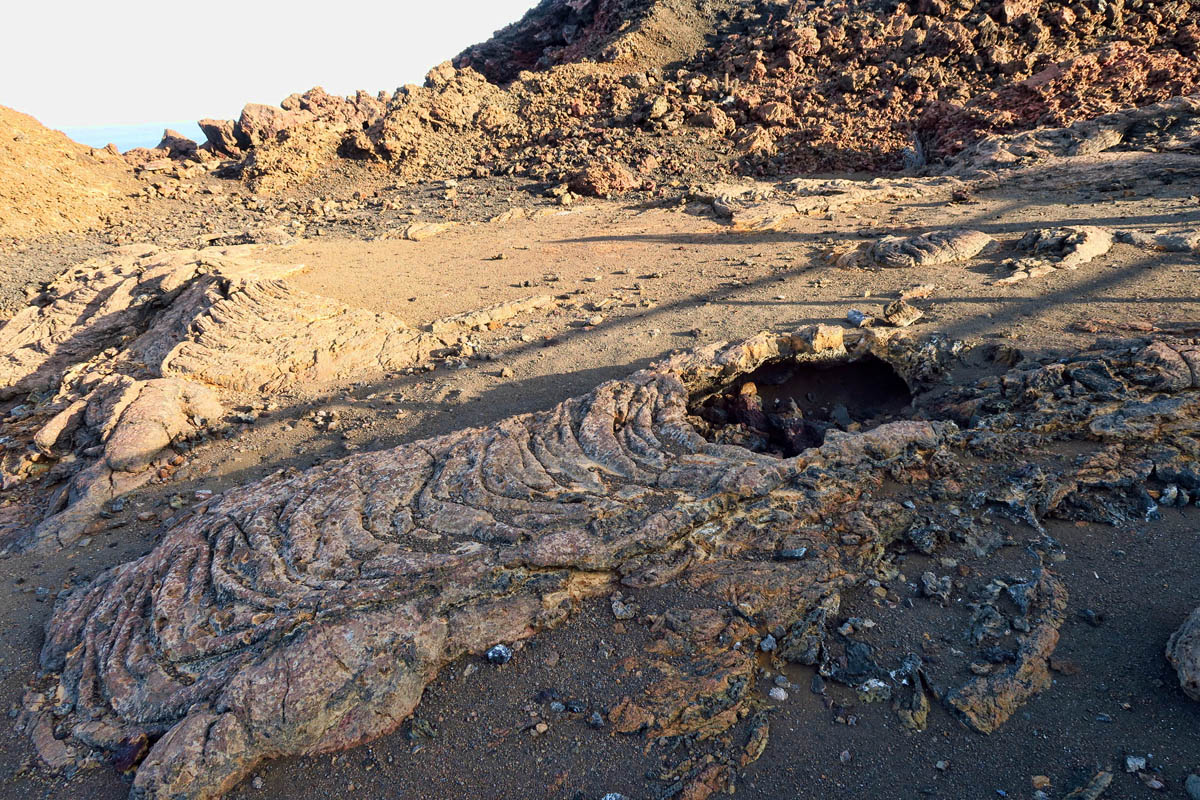
In the lower half of the photo on top of the lava tube is an example of “pahoehoe,” or ropy lava, and in the top half of the photo, “aa” orsharp, jagged lava.

Although lighting is not ideal looking towards Pinnacle Rock, it’s golden glow is beautiful on the lava.
Both a blessing and a curse, we are here at a lovely time of the evening, just as the sun is sinking low to the horizon, casting a golden glow over the seascape. But we are also facing into the western sun, which is obscuring the typically vivid blues and greens of this iconic view. Still, the view is stunning, and very ethereal with the soft evening breezes lowering the temperature as the sun drops.

This is the iconic view out over the isthmus and Pinnacle Rock. Unfortunately, setting sun distorts the colors.
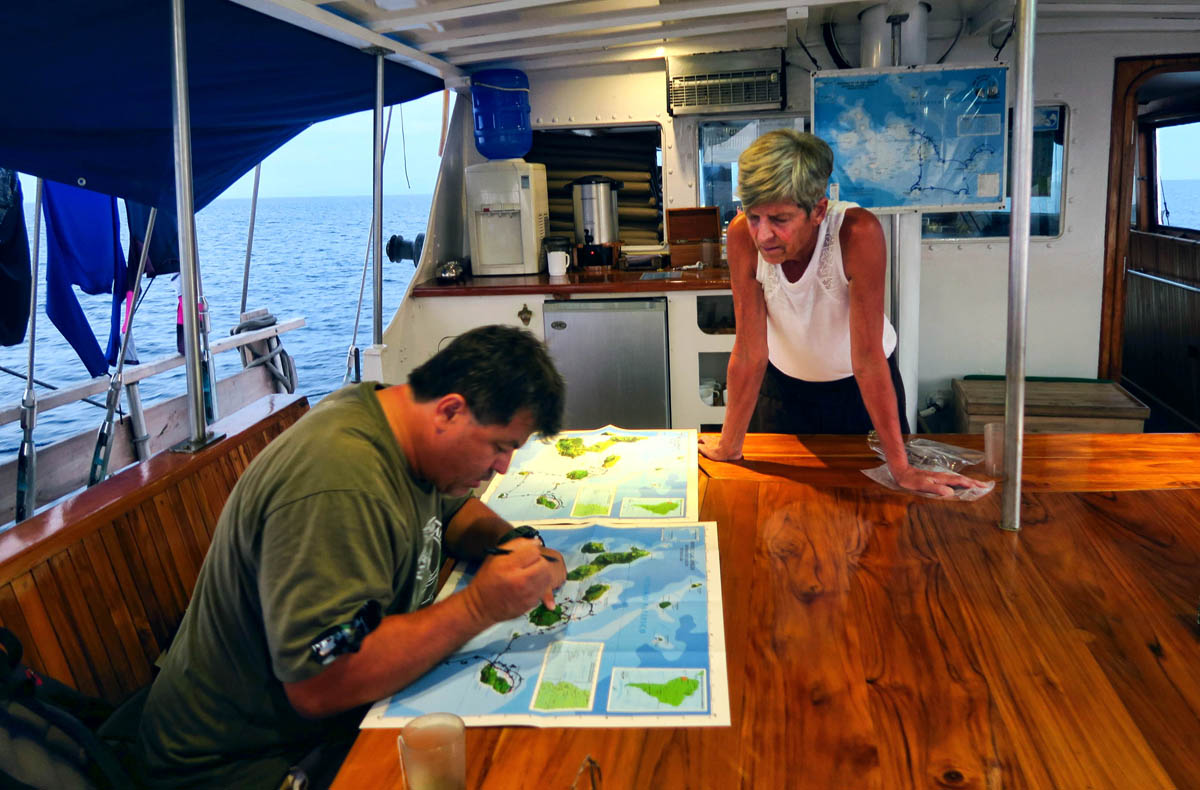
Kathy and I bought souvenir charts of the islands when we were back in San Cristobal. Fabian is filling in our charted course.
Back on board, dinner is rice and beans (groan!) with curried beef, but the chef makes up for the beans by serving a lovely flan for dessert.
“Man tends to increase at a greater rate than his means of subsistence.” ~ Charles Darwin






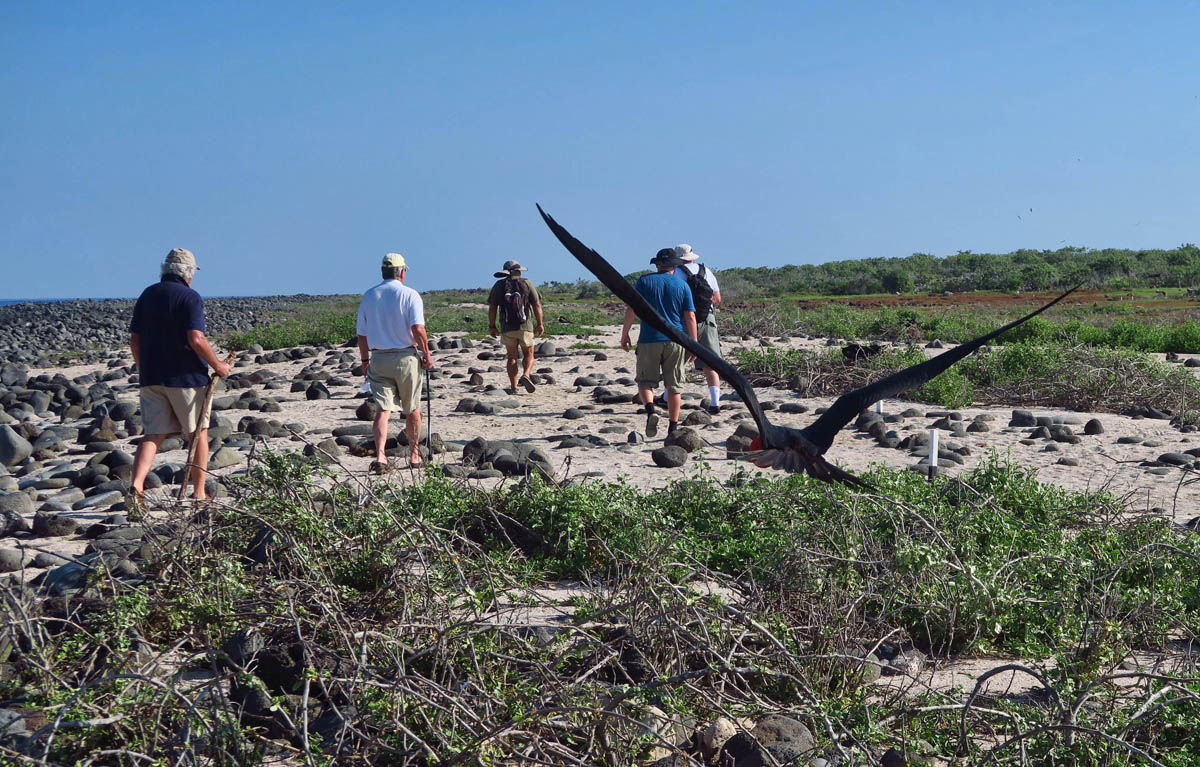









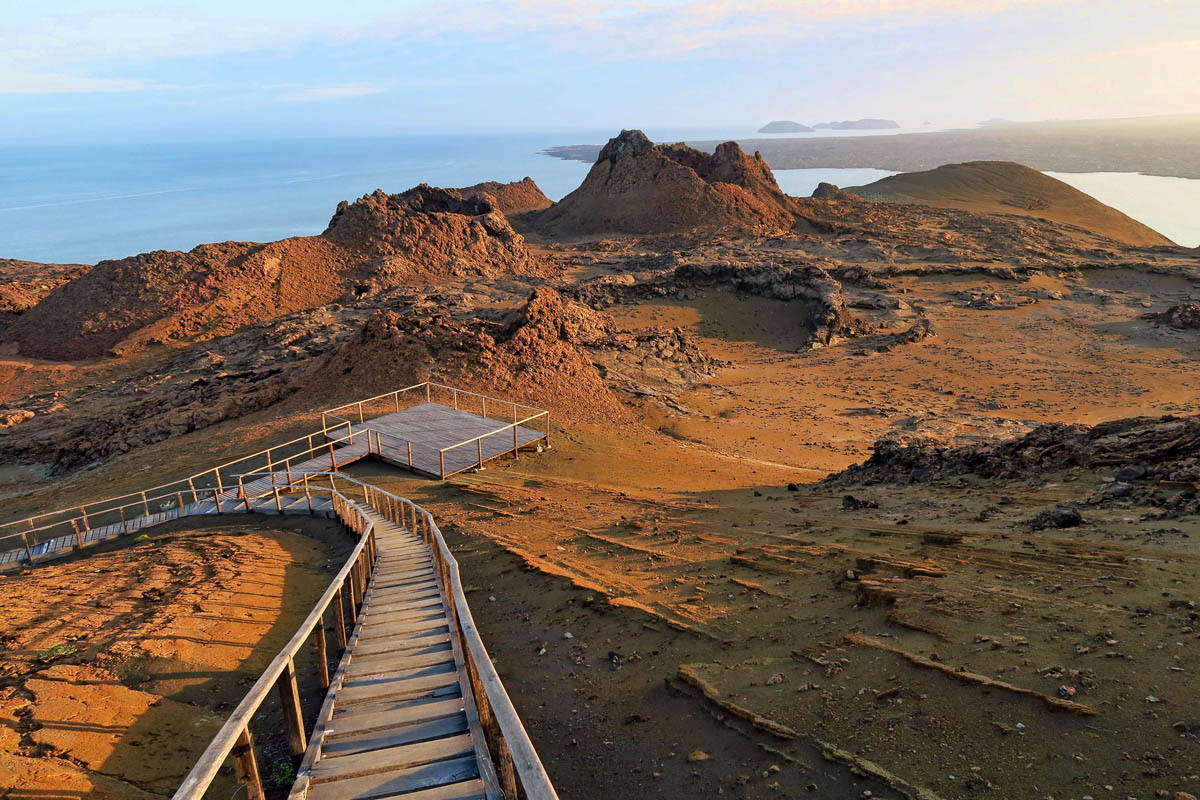

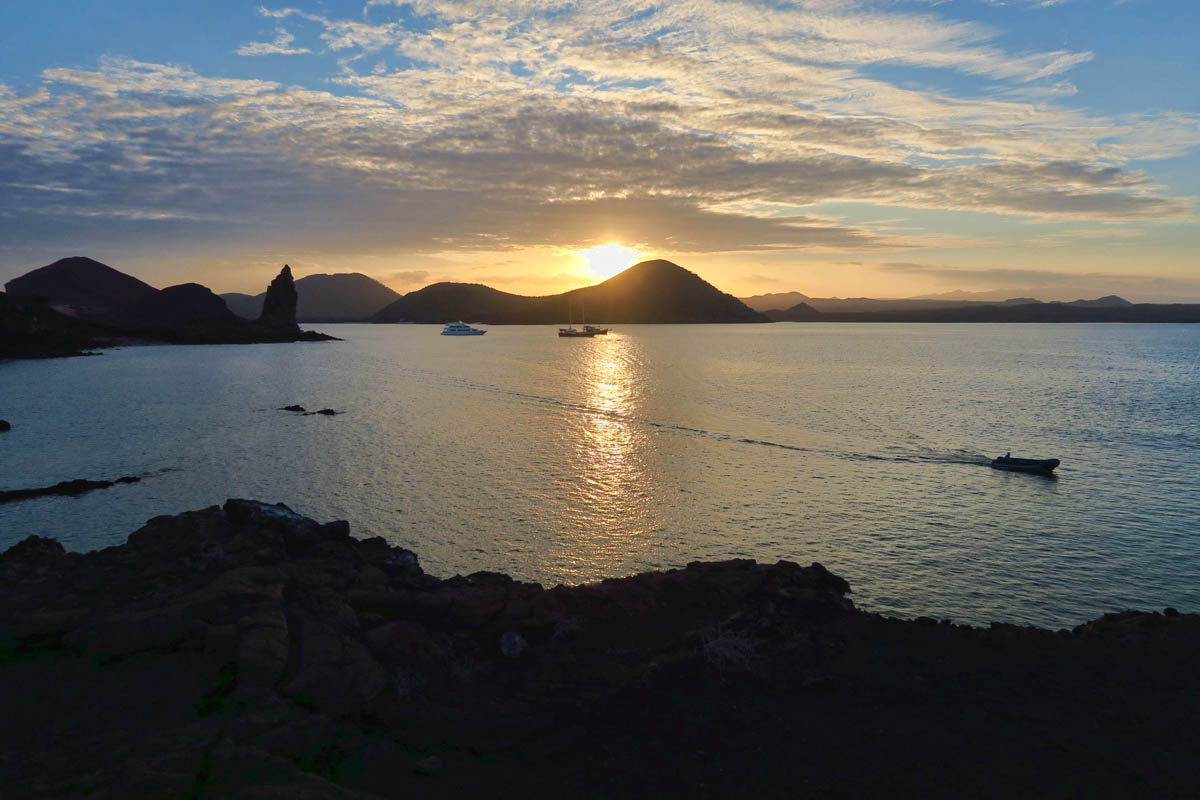
Such a wonderful experience you are enjoying. Thank you so much for sharing! I feel like I am there with you.
Yes! I feel like I am there with you! Having a wonderful time, thank you Suzanne 🙂
I want to thank you again, this time because I just did not ‘get’ why the Galapagos were so important in the discovery of evolution. I am an engineer who worked with hard logic and sometimes soft logic takes me a bit longer. Your text telling what you saw along with your pictures of what you saw on each island lit the light of knowledge for me. Nowhere else does there seem to be so much detail on evolution to meet different needs in so compact an area than in the Galapagos. The difference in land and sea lizards, tortoise, and birds between the islands must have really opened the eyes of Darwin as it finally did for me. I have been a believer in evolution but it was taught to me while Darwin got to see it. I can hardly wait until the grand daughters come back and Pa can go through all of the Galapagos blogs and show them what I now understand. Thanks Suzanne and I await day 6. Time does fly when one is enjoying life.
The Frigates sure are interesting and the landscape it incredible!
Thank you for all the photos of places that I would never be able to get to these days. What a different environment along with unique creatures.
LOVE the boat and would have so enjoyed that aspect.
The trip looks like it was all and more then you expected.
How wonderful!
What a treasure trove of delight I am relishing this early May Saturday morning! Intentionally, I’ve saved your Galapagos posts from the beginning to savor all at once–I wanted to be there with you in a continuous chain of wonder as if I were gliding through it all without pause. I simply could not resist temptation to wait to the end of your magnificent journey through the islands, though, so here I am…at Pinnacle Rock, not wanting the venture to end.
The iguanas and boobies and gulls and seals…all beautifully photographed while describing natural habits–so interesting! I laughed out loud at the description of the blue-footed booby’s mating dance, I marveled at the stature of Kicker Rock, I salivated at that Los Coquerios coconut cream bar (oh, my!). And the swallow-tailed gull with the red eye ring…colorful and fascinating! It is gratifying to see the government at large take Galapagos conservation seriously, from efforts to eradicate swimming rats to constructing boardwalks to protect land…preserving the past for future life in this paradise sanctuary in the Pacific Ocean.
Certainly, it did not go unnoticed that, throughout this island journey, your underlying theme is a cautionary tale: conservation of the past is important, but a greater warning is to protect our future before it dissolves around us.
All of your quotes have held meaning for me, but this one went straight to my heart with a frighteningly pointed arrow: “One of the things Darwin’s work has taught us is that we break nature’s connections at our peril. Yet break them, we do, at ever-greater speed. The impacts of our growing population and our consumption now directly threaten our own future.” ~ Sir David Attenborough
Thank you, Suzanne, for sharing this wondrous trip with us. 🙂
Hey, Rhonda! So good to see you back in my comment section again! I never want to feel like I am chasing commentors. If people want to comment, I welcome them, but if they don’t, I’m likely going to keep writing anyway, because writing brings me joy. But after a while, regular commentors begin to feel more like friends. And when those friends don’t show up in the comment box, I start to wonder if all is okay. Particularly when it’s friends like you and Allen that don’t have a blog I can check up on. So it’s good to hear from you.
Thanks as always for your wonderfully thought out comments which make me feel “understood.” haha! And thanks for sticking with me, my friend.